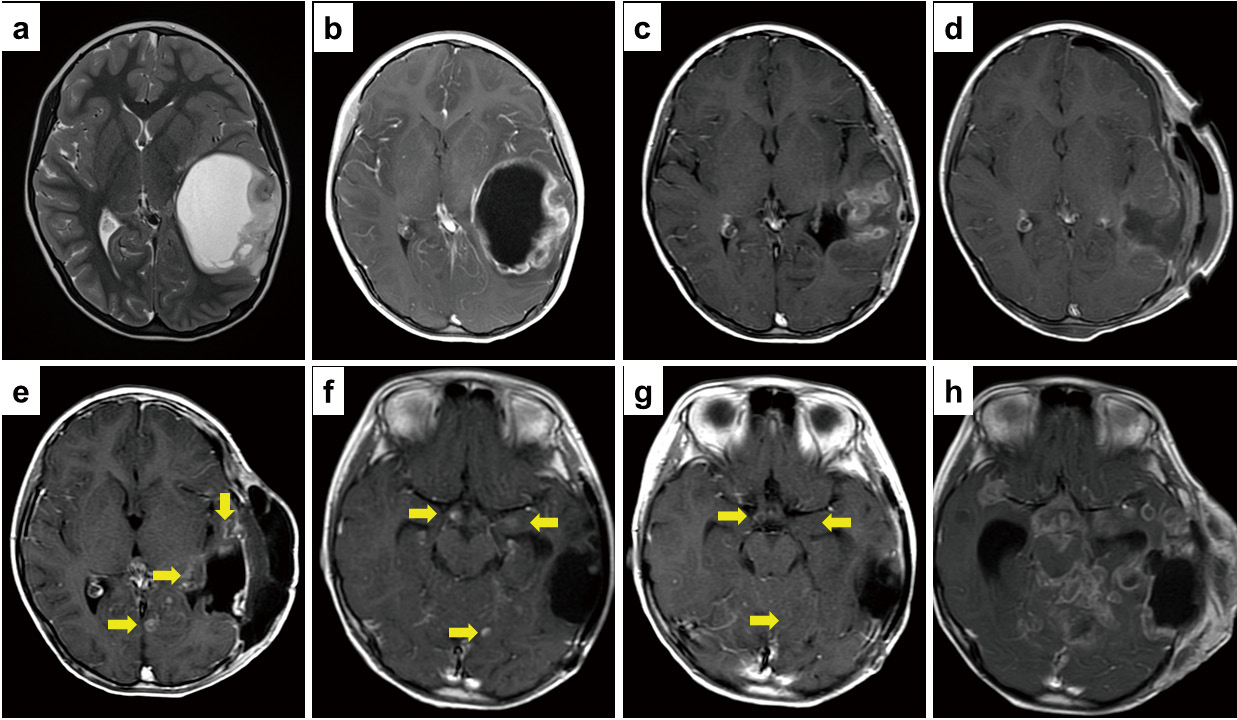- 著者
- Kentaro CHIBA Yasuo AIHARA Yuichi ODA Kenta MASUI Takashi KOMORI Hideaki YOKOO Takakazu KAWAMATA
- 出版者
- The Japan Neurosurgical Society
- 雑誌
- NMC Case Report Journal (ISSN:21884226)
- 巻号頁・発行日
- vol.10, pp.265-271, 2023-12-31 (Released:2023-10-14)
- 参考文献数
- 32
Extracranial brain tumor metastases are extremely rare. The etiology, pathophysiology, and clinical progression of systemic metastatic brain cancer remain to be elucidated. We encountered a case of pediatric diffuse high-grade astrocytoma in a four-year-old girl with subcutaneous and lymph node metastases. Numerous metastatic lesions emerged, progressed rapidly, and were difficult to manage despite temozolomide (TMZ) administration. The patient underwent repeated surgical resection for these lesions. Conversely, the primary intracranial lesions responded well to TMZ for some time. However, the patient died 15 months after the initial diagnosis. Extracranial metastasis and highly varying effects of chemotherapy were the characteristic clinical features in this case. Our analysis did not reveal definitive histopathological and molecular factors contributing to this presentation. The lack of notable molecular pathological features illustrates the unpredictability of glioma metastasis, and the treatment for extracranial metastasis remains unknown. A gene panel analysis revealed several genetic aberrations, including PDGFRA, PIK3CA, and NBN mutations. As it is impossible to resect all frequently and rapidly progressing lesions, we stress that the prognosis of metastatic brain tumors is undoubtedly poor if these tumors are refractory to existing treatments, including chemotherapy.
- 著者
- Yuichi ODA Kosaku AMANO Kentaro CHIBA Kenta MASUI Takakazu KAWAMATA
- 出版者
- The Japan Neurosurgical Society
- 雑誌
- NMC Case Report Journal (ISSN:21884226)
- 巻号頁・発行日
- vol.10, pp.285-289, 2023-12-31 (Released:2023-10-14)
- 参考文献数
- 19
As per the 2021 World Health Organization (WHO) Classification of Tumors of the Central Nervous System, chordoid glioma (CG) is defined as a slow-growing glial neoplasm categorized as grade II tumor. This tumor is primarily located in the anterior part of the third ventricle, often adheres to important surrounding structures, and is hemorrhagic in nature. Therefore, dissecting this tumor is extremely difficult. In this study, we present the case of a 44-year-old man who initially complained of mild headache and was diagnosed with a homogeneous gadolinium-enhanced lesion in the third ventricle via magnetic resonance imaging. The pathological diagnosis based on his biopsy at the previous hospital was CG. The patient demonstrated no neurological deficit at that time, but the tumor had gradually grown, hydrocephalus appeared 2 years after the tumor was detected, and the patient developed short memory disorder and daytime sleepiness. We resected the tumor via the anterior interhemispheric trans-lamina terminalis approach using a microscope and an endoscope. The residual tumor at the blind spot of the microscopic view was resected under an angled rigid endoscopic view using dedicated tools for transsphenoidal surgery. The tumor was grossly resected, and the histopathological diagnosis was CG. Postoperative neurological findings included slight memory disorder and hypothalamic adrenal dysfunction. No tumor recurrence was reported 3 years post resection. The endoscope-assisted anterior interhemispheric trans-lamina terminalis approach was determined useful for CG resection with minimal surgical complications and without tumor recurrence.

